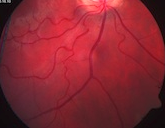Members Login

Channels
Special Offers & Promotions
Research that More than Meets the Eye: New Technique Analyses Blood Flow in Glaucoma Patients
The link between blood flow in the retina and the development of glaucoma can now be measured accurately for the first time.
 This was made possible by the further development of an established measurement method, optical coherence tomography (OCT), which enables the visual assessment of the retina and has thus become an important diagnostic tool. It does not, however, provide any information about retinal function. With the support of the Austrian Science Fund FWF, a research team at the Medical University of Vienna has succeeded in making a significant improvement to the technique so that it can now also be used to measure the blood flow in the retina. The value of this information in the context of the progression of glaucoma is now being established in a comparative study.
This was made possible by the further development of an established measurement method, optical coherence tomography (OCT), which enables the visual assessment of the retina and has thus become an important diagnostic tool. It does not, however, provide any information about retinal function. With the support of the Austrian Science Fund FWF, a research team at the Medical University of Vienna has succeeded in making a significant improvement to the technique so that it can now also be used to measure the blood flow in the retina. The value of this information in the context of the progression of glaucoma is now being established in a comparative study.
Our eyes also come under considerable pressure at times – and suffer enormous damage as a result. Specifically, the nerve cells in the retina are affected by increased eye pressure (glaucoma). This leads to irreversible damage in the optic nerve head, the destruction of the nerve cells and visual field defects. However, raised eye pressure can also potentially cause a reduction in blood flow to the retinal tissue. The extent to which this mechanism is responsible for the death of the nerve cells is disputed. While raised eye pressure is acknowledged as the main cause, there are increasing indications that the retinal blood flow can also be a contributing factor. Due to the lack of reliable measuring methods, it was not possible to test retinal blood flow up to now. A research team at the Medical University of Vienna (MUW), with the support of the Austrian Science Fund FWF, has changed this and is now embarking on an initial study to confirm the role played by vascular factors in glaucoma.
FLOW MEASUREMENT
Commenting on the study, its leader, Professor Leopold Schmetterer from the Center of Medical Physics and Biomedical Engineering at the MUW, explains: "For the first time we will be able to measure the absolute retinal blood flow in glaucoma patients. To do this, we are testing the hypothesis that the blood flow in the retina is reduced in glaucoma. At the same time we will also evaluate the technology we developed – in particular its suitability for the long-term analysis of retinal blood flow in individual patients."
The technology optimised by Prof. Schmetterer and his team is called "Fourier Domain Optical Doppler Tomography" (FDODT) and involves the further development of optical coherence tomography (OCT). In addition to recording cross-section images of the retina, the technique can now also be used to quantify the blood flow. Thanks to further optimisations by Prof. Schmetterer and his team, the method can now record the absolute blood flow in the retina and thereby provide information about its influence on glaucoma.
PRACTICAL TEST
The technology is now undergoing a critical evaluation as part of a comparative study with over 80 participants. As part of the study, the blood flow in the retinas of glaucoma patients is being compared with that of healthy control subjects. Other aspects of glaucoma are also being examined, as Prof. Schmetterer explains: "We are also analysing whether the self-regulation of the blood flow in the optic disc is defective in glaucoma." The vessels in the retina can actually regulate the blood flow themselves. This ensures that the oxygen supply to the retinal cells is not altered in the event of a fall in blood pressure. It was not previously possible to establish whether this self-regulation is defective in glaucoma patients. Thanks to the technical advances made by Prof. Schmetterer, this has now changed.
This medically important study is receiving support from the FWF's clinical research programme (KLIF). The aims of this programme include the optimisation of diagnostic and therapeutic processes. The best way of achieving this is to evaluate the FDODT in the context of a clinical study and thus contribute to improving the treatment of one of the leading causes of blindness in industrialised countries.
Media Partners


